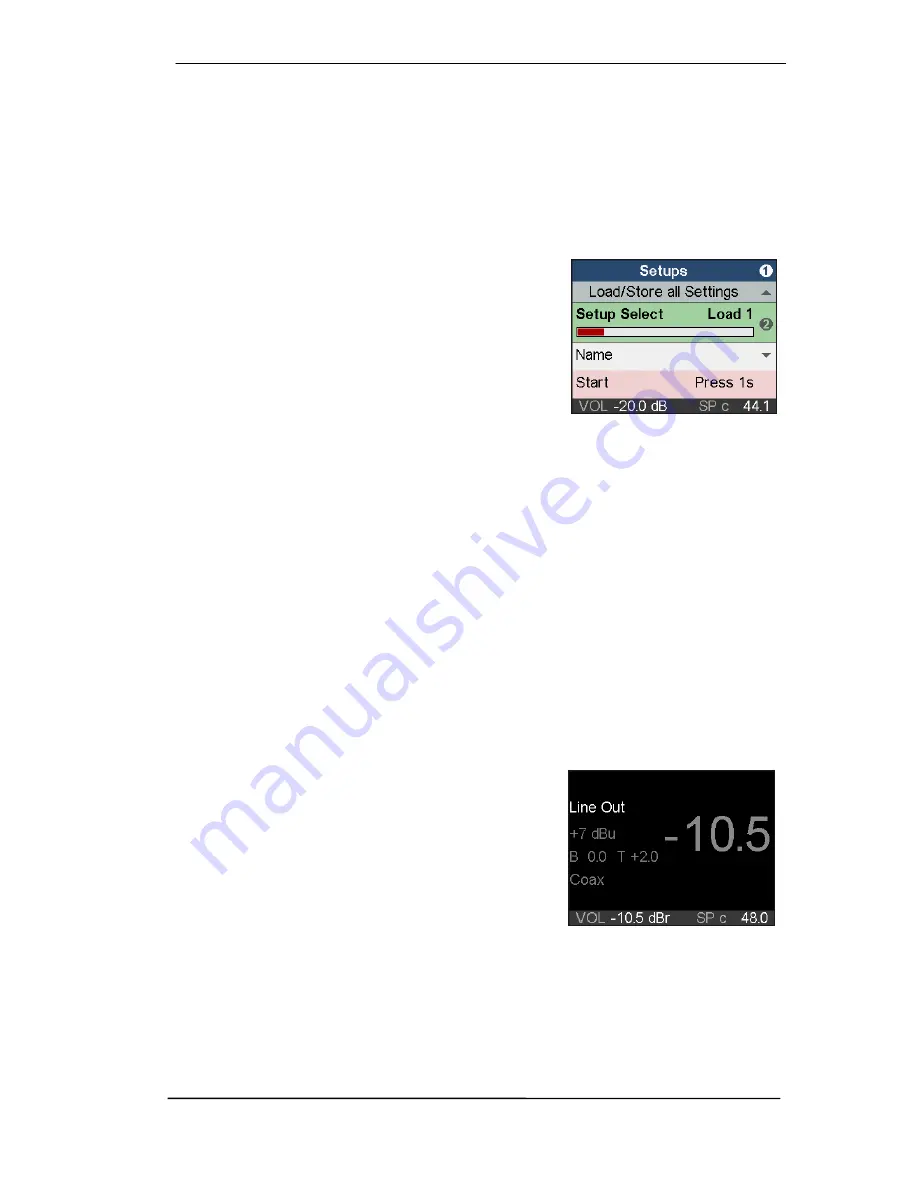
User’s Guide ADI-2 DAC
© RME
27
14.2 Load/Store all Settings
This option allows to save the whole state of the unit as Setup in up to 9 different memory slots.
The EQ Presets are not included, they are stored separately and are available for any setup.
The current state of the EQ is also stored. During load of a Setup the EQ is written to the mem-
ory slot
Manual
.
The page
Setups, Load/Store all Settings,
has the following entries:
Setup Select
Choices are memory slots 1 to 9 and Factory (factory
default).
Operation
Choices are Load and Store.
Start
Press 1s. Pressing and holding encoder 2 for at least one
second triggers the action selected in Operation (Load or
Store).
Returning to Factory State
In case a total reset is desired: hold encoder 1 and the VOL button pushed while turning on the
unit. This will reset all current settings to factory default. User-stored Setups and EQ presets are
not affected.
15. Top Screens
The ADI-2 DAC has three different top screens: an Analyzer showing the audio signal content
of the analog outputs, a state overview showing the digital states of SPDIF and USB, and a dark
Volume screen with additional information.
Pushing the small encoder 1 or 2 cycles through them if any is currently active. To quickly call
them up simply press any of the four function keys one or two times. The remote can be used
as well after assigning 'Toggle View' to one of the four programmable buttons.
15.1 Dark Volume
This screen has been added as alternative to the other
meter screens, which even with the dark theme selected
might be disturbing in some situations.
Dark Volume
shows
the current volume setting, the current reference level
setting, the amount of Bass/Treble gain applied and the
currently used input or source. It is low in brightness, still
fully readable in bright environments, and has zero flickering
or moving elements (level meters). Volume and Bass/Treble
adjustments happen right in this screen, which makes its
functionality not only visually pleasing.
Despite this screen having no level meters, overloads caused by Volume, PEQ or Bass/Treble
are easy to recognize. The big volume numbers are coupled to the over detection of the analog
outputs. They change their color to red when overloads occur.
As with the other top screens, once selected it becomes the default screen, automatically
shown after power-up or when leaving a menu.
Summary of Contents for ADI-2 DAC
Page 9: ...User s Guide ADI 2 DAC RME 9 5 4 Overview Menu Structure...
Page 17: ...User s Guide ADI 2 DAC RME 17 User s Guide ADI 2 DAC Operation Controls and Display...
Page 33: ...User s Guide ADI 2 DAC RME 33 User s Guide ADI 2 DAC Inputs and Outputs...
Page 37: ...User s Guide ADI 2 DAC RME 37 User s Guide ADI 2 DAC Installation and Operation Windows...
Page 42: ...42 User s Guide ADI 2 DAC RME...
Page 43: ...User s Guide ADI 2 DAC RME 43 User s Guide ADI 2 DAC Installation and Operation Mac OS X...
Page 46: ...46 User s Guide ADI 2 DAC RME...
Page 47: ...User s Guide ADI 2 DAC RME 47 User s Guide ADI 2 DAC Installation and Operation iOS...
Page 49: ...User s Guide ADI 2 DAC RME 49 User s Guide ADI 2 DAC Technical Reference...
Page 54: ...54 User s Guide ADI 2 DAC RME 31 4 Filter Curves 44 1 kHz 31 5 Frequency Response...
Page 56: ...56 User s Guide ADI 2 DAC RME 31 7 Total Harmonic Distortion Measurements 31 8 Loudness...
Page 57: ...User s Guide ADI 2 DAC RME 57 31 9 Extreme Power Charts...
Page 64: ...64 User s Guide ADI 2 DAC RME 31 16 Block Diagram...
Page 65: ...User s Guide ADI 2 DAC RME 65 User s Guide ADI 2 DAC Miscellaneous...






























